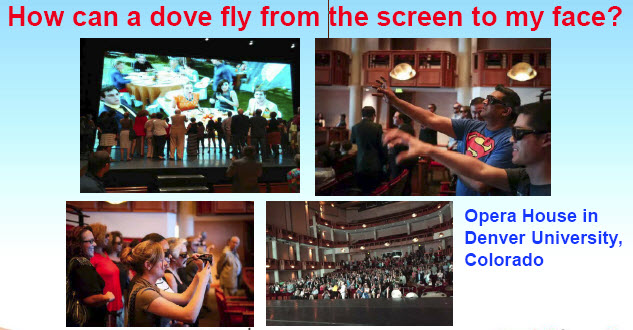
Chao Li has a research centre for 3D in China which is focused on 3D with LEDs. He has looked at the human factors in detail. To start, Li asked three questions:
- Why does a 3D movie projection produce 3D vertigo?
- Why does shutter mode LED cause fatigue?
- If the eye has persistence of 20ms, why do you have to refresh LEDs @ 300 Hz to get a comfortable view?
Prof Angelo G Solimini of the Sapienza University of Rome has researched the issue of discomfort from 3D and saw a big ‘unwell feeling’, but Chau said his own research on LED 3D shows the same results as from 2D.
So is it the video source, or content or the display system? The keyword for Li, after much research, which has generated a number of patents, is ‘genlock’ – content must be gen locked at the pixel level, not just at the frame or line level. That’s important at the camera, through transmission and in display.
Work is easier in #1 and #2, but harder for the display. Film in 3D can see different jitter and LCDs or DLPs could be slightly differently timed, Li said, but with LED you can be sure there is no timing issue.
Humans have two eyes, but don’t get trouble with the unwell feeling from the real world. That’s because the eyes are perfectly synchronised in life. It’s critical to get absolute sync at pixel level, Li said.
40 people were tested with a synchronised system and none reported feelings of ‘unwellness’.
Originally, Li started working with a ‘shutter mode’ LED 3D display, but it caused fatigue in the audience although it was not clear why. It was tried in 1997, but was not accepted in the US, so he switched to use a polarising mode. He found the same level of fatigue with 25 minutes of polariser-based 3D as 2.5 hours of shutter mode.
How about the well known persistence of human vision of 20ms for cinema? Persistence is only that level because of the low brightness, Li said. He found this out with a big LED display for the 1998 Sydney Asian Games which was 1000 cd/m² and needed 100Hz to be comfortable, but for 3000 cd/m², the eye needs 300Hz.
 Li’s CCDL 3D technology could be very good in theatre and opera
Li’s CCDL 3D technology could be very good in theatre and opera
High definition alongside 3D has been the target in entertainment for 100 years and Li wants to get to this, eventually with ‘naked eye’ 3D.
Li has done many projects in sports and opera houses using the polarising 3D. There are also applications in VR and education where the contrast and brightness is much better than tradition
Li then compared projection with LED performance.
In questions, Li said he is hoping to get funding to check if the same synchronisation issues apply in VR headsets. He also said that for 10-12 m screens, he recommends 6 mm (h pitch) with 3mm (v pitch) for polarisation. For 20m, the pitch should go to 10 H (5 V). (The LEDs are asymetric, with twice the pitch horizontally compared to vertically, so that each image is at full resolution).
Analyst Comment
I was somewhat sceptical when I heard this talk, but when I saw the LED displays, using polarising technology, at the show, I was converted. The content was over-dramatic in its use of 3D, but I was very impressed.

